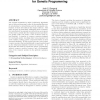286 search results - page 28 / 58 » The Distribution of Genomic Distance between Random Genomes |
103
click to vote
DAC
2007
ACM
16 years 10 days ago
2007
ACM
Randomness is inherent to biochemistry: at each instant, the sequence of reactions that fires is a matter of chance. Some biological systems exploit such randomness, choosing betw...
JCB
2002
14 years 11 months ago
2002
At least 43% of the human genome is occupied by repetitive elements. Moreover, around 51% of the rice genome is occupied by repetitive elements. The analysis of repetitive element...
105
click to vote
GECCO
2010
Springer
15 years 4 months ago
2010
Springer
The original mechanism by which evolutionary algorithms were to solve problems was to allow for the gradual discovery of sub-solutions to sub-problems, and the automated combinati...
WIOPT
2006
IEEE
15 years 5 months ago
2006
IEEE
— We introduce and discuss a novel link model that incorporates both uncertainty in the fading coefficients and the node distances for ad hoc networks with randomly placed nodes...
142
click to vote
BMCBI
2011
14 years 5 months ago
2011
Background: Genome-wide single-nucleotide polymorphism (SNP) arrays containing hundreds of thousands of SNPs from the human genome have proven useful for studying important human ...


